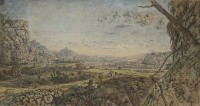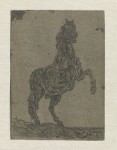 Hercules Segers (ca. 1589 – ca. 1638) is not widely known today, but he had an enormous influence on far more famous artists of the Dutch Golden Age and the rediscovery of his works in the 19th century played a major role in the development of the modern graphic arts. Very little is known about his life. He lived and worked in comparative obscurity, experimenting with print media in a way that had never been done before and wouldn’t be done again for 400 years.
Hercules Segers (ca. 1589 – ca. 1638) is not widely known today, but he had an enormous influence on far more famous artists of the Dutch Golden Age and the rediscovery of his works in the 19th century played a major role in the development of the modern graphic arts. Very little is known about his life. He lived and worked in comparative obscurity, experimenting with print media in a way that had never been done before and wouldn’t be done again for 400 years.
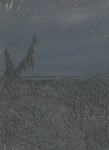 After his death, apparently from falling down the stairs while drunk, his innovative work became highly sought after, particularly by fellow artists. It was his innovative approach to printmaking that made his name. Even to contemporary eyes, his prints are incredibly fresh: moody imaginary landscapes, each print unique thanks to his constant experimentation with colored inks, tints, colored paper, cloth, textures and cropping.
After his death, apparently from falling down the stairs while drunk, his innovative work became highly sought after, particularly by fellow artists. It was his innovative approach to printmaking that made his name. Even to contemporary eyes, his prints are incredibly fresh: moody imaginary landscapes, each print unique thanks to his constant experimentation with colored inks, tints, colored paper, cloth, textures and cropping.
 There are only 183 Segers prints made from 54 plates known to survive, each of them unique. A print by Rembrandt van Rijn is actually by Hercules Segers too. Rembrandt was an avid fan and collector of Segers’ art, and reworked one of Segers’ copper plates, Tobias and the Angel, into his Flight into Egypt, keeping the landscape unchanged but altering the human figures. Rembrandt also collected Segers’ paintings, owning at least eight of them. Considering that only 12 Segers paintings were known to have survived into our time, that’s an impressive proportion.
There are only 183 Segers prints made from 54 plates known to survive, each of them unique. A print by Rembrandt van Rijn is actually by Hercules Segers too. Rembrandt was an avid fan and collector of Segers’ art, and reworked one of Segers’ copper plates, Tobias and the Angel, into his Flight into Egypt, keeping the landscape unchanged but altering the human figures. Rembrandt also collected Segers’ paintings, owning at least eight of them. Considering that only 12 Segers paintings were known to have survived into our time, that’s an impressive proportion.
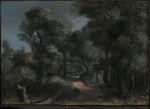 Now that number has been expanded by 50% because researchers at the Rijksmuseum have authenticated another six paintings by Hercules Segers, all of them held in private collections. A team of specialists spent two years studying about 100 disputed or possible Segers paintings and prints for an upcoming exhibition, discovering works never before displayed to the public and confirming the authenticity of works that have been deemed doubtful at best for decades. They enlisted the latest and greatest technology in their pursuit, including infrared reflectography, X-ray fluorescence, ultraviolet photography and dendrochronological analysis on the wood panel paintings.
Now that number has been expanded by 50% because researchers at the Rijksmuseum have authenticated another six paintings by Hercules Segers, all of them held in private collections. A team of specialists spent two years studying about 100 disputed or possible Segers paintings and prints for an upcoming exhibition, discovering works never before displayed to the public and confirming the authenticity of works that have been deemed doubtful at best for decades. They enlisted the latest and greatest technology in their pursuit, including infrared reflectography, X-ray fluorescence, ultraviolet photography and dendrochronological analysis on the wood panel paintings.
The three paintings, Woodland Path, Panoramic Landscape with a Town on a River and Panoramic Landscape with Two Towers, all owned privately, have never been seen before. The Mountain Landscape from Hovingham Hall in England was last shown almost fifty years ago. Alongside the four works by Segers, there
are two other paintings from private collections that have long been considered doubtful but may now also be definitively added to Segers’ oeuvre. They are the River Landscape with Figures and River Landscape with a Mill. Two new prints by the artist have also been found.
 The team’s extensive art historical and technical research also revealed new information about Segers’ work and materials. For instance, they found that Segers used painter’s materials in his etchings, using oil paints to make the prints. He used different paper, textiles and paints for every impression, which is why they’re all so different from each other. Hercules Segers was, researchers discovered, the first European artist to use paper from east Asia, beating Rembrandt to the punch by 20 years.
The team’s extensive art historical and technical research also revealed new information about Segers’ work and materials. For instance, they found that Segers used painter’s materials in his etchings, using oil paints to make the prints. He used different paper, textiles and paints for every impression, which is why they’re all so different from each other. Hercules Segers was, researchers discovered, the first European artist to use paper from east Asia, beating Rembrandt to the punch by 20 years.
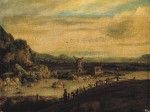 The Rijksmuseum’s research will bear fruit in an unprecedented retrospective bringing together almost all of Hercules Segers’ works. All 18 of his extant paintings and 110 of his prints will be on display at the museum from October 7th, 2016, until January 8th, 2017. At the same time, the Rembrandt House Museum will put on an exhibition, Under the Spell of Hercules Segers, about the influence of Hercules Segers on Rembrandt and other Golden Age Dutch artists, as well as his influence on graphic artists in the 20th century. After it closes at the Rijksmuseum, the Hercules Segers exhibition will then travel to the Metropolitan Museum of Art in New York City where it will open on February 13th as The Mysterious Landscapes of Hercules Segers.
The Rijksmuseum’s research will bear fruit in an unprecedented retrospective bringing together almost all of Hercules Segers’ works. All 18 of his extant paintings and 110 of his prints will be on display at the museum from October 7th, 2016, until January 8th, 2017. At the same time, the Rembrandt House Museum will put on an exhibition, Under the Spell of Hercules Segers, about the influence of Hercules Segers on Rembrandt and other Golden Age Dutch artists, as well as his influence on graphic artists in the 20th century. After it closes at the Rijksmuseum, the Hercules Segers exhibition will then travel to the Metropolitan Museum of Art in New York City where it will open on February 13th as The Mysterious Landscapes of Hercules Segers.

